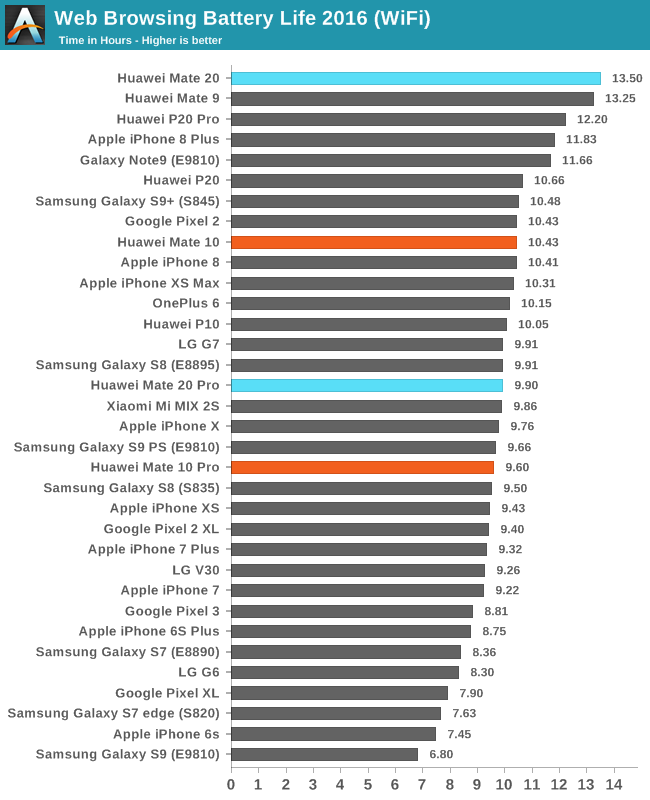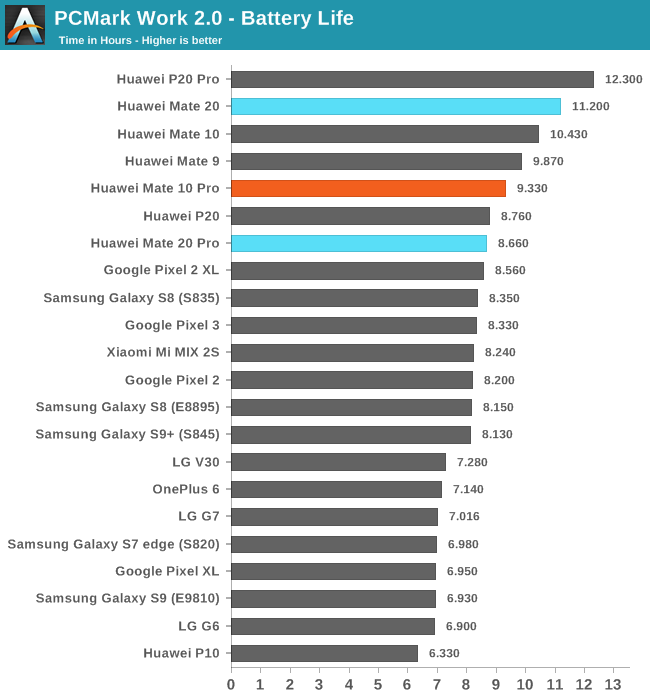The Mate 20 & Mate 20 Pro Review: Kirin 980 Powering Two Contrasting Devices
by Andrei Frumusanu on November 16, 2018 8:10 AM EST- Posted in
- Smartphones
- Huawei
- Mobile
- Kirin 980
- Mate 20
- Mate 20 Pro
Battery Life - Contrasting Two Models
The Mate 20 comes with an LCD screen and a 4000mAh battery. The screen is slightly larger in area than that of the Mate 20 Pro, who in turn uses an OLED screen, but also features a slightly larger 4200mAh battery.
The Kirin 980 of both phones should provide great efficiency, although I have to note that my units of the Mate 20 Pro seemed to have a worse binned SoC, as active system power consumption (normalised for screen and idle) in SPEC was about 8-9% higher than on the Mate 20.

In the web browsing test, we see the regular Mate 20 post some new record battery life results, with a staggering runtime of 13.5h. Here we finally see Huawei replicate the results of the Mate 9, which similarly had a very efficient screen. The efficiency of the SoC also augments the phone above that of other devices.
On the Mate 20 Pro, we see the previously discovered screen panel issues come back to haunt it. Even though it has a larger battery and a smaller screen than the Mate 20, the more expensive phone fares worse off in the test. Unfortunately the large base power handicap of the phone along with slightly worse luminance efficiency is the main cause of the results.
In regards to the Mate 10 results: The actual battery life of devices on the stock firmware should be better, unfortunately I haven’t been able to get to get back to this version as my units have a variant that unlock the memory controller to its full speed (and reduces battery life).

In PCMark, we see a similar regression on the part of the Mate 20 Pro – the regular version is achieving excellent results. Here the test is favourable to OLED devices, as evidenced by the P20 Pro leading all our results, however again this increase base power consumption of the Mate 20 Pro costs it a lot of lifetime which ends up it having much reduced battery life compared to where the SoC and battery capacity should have been capable of.
Overall, there’s two conclusions here in regards to battery life:
The Mate 20 is just an outstanding device and is currently showcasing absolutely leading battery life. Most devices with such runtimes are lower or mid-range phones with large battery capacities. In the high end, the Mate 20 is essentially in a tier of its own as it achieves this excellent battery life result while also showcasing the best performance of an Android device.
The Mate 20 Pro’s result and conclusion is a bit more muted. Its battery life isn’t bad, but falls short of expectations. Here the 4200mAh battery serves as no more than to just compensate for the inefficient display.










141 Comments
View All Comments
SydneyBlue120d - Friday, November 16, 2018 - link
I'd like to see some mobile speed test compared with Snapdragons and Intel modems :)Great review as always, included the Lorem Impsum in the video recording video page :P
Andrei Frumusanu - Friday, November 16, 2018 - link
Cellular tests are extremely hard to do in non-controlled environments, it's something I'm afraid of doing again as in the past I've found issues with my past mobile carrier that really opened my eyes as to just how much the tests are affected by the base station's configuration.I'm editing the video page, will shortly update it.
jjj - Friday, November 16, 2018 - link
When you do the GPU's perf per W, why use peak not hot state average? And any chance you have any hot perf per W per mm2 data, would be interesting to see that.Have you checked if the Pto with max brightness throttles harder and by how much?
Hope LG can sort out power consumption for their OLED or they'll have quite some issues with foldable displays.
Andrei Frumusanu - Friday, November 16, 2018 - link
It's a fair point, it's something I can do in the future but I'd have to go back measure across a bunch of deices.What did you mean by Pto? The power consumption of the screen at max brightness should be quite high if you're showing very high APL content, so by definition that is 2-3W more to the TDP, even though it's dissipated on a large area.
jjj - Friday, November 16, 2018 - link
The Pro question was about the SoC throttling harder because of the display, could be and should be the case to some extend, especially if they did nothing about mitigating it but was curious how large the impact might be in a worse case scenario. - so SoC throttling with display at min power vs max power.Also related to this, does heat impact how brightness is auto-adjusted?
Andrei Frumusanu - Friday, November 16, 2018 - link
The 3D benchmarks are quite low APL so they shouldn't represent any notable difference in power. Manhattan for example is very dark.jjj - Friday, November 16, 2018 - link
I suppose you could run your CPU power virus while manipulating the display too, just to see the impact. The delta between min and max power for the display is so huge that you got to wonder how it impacts SoC perf.Chitti - Friday, November 16, 2018 - link
Nothing about speakers and sound output via USB-C and in Bluetooth earphones ?Andrei Frumusanu - Friday, November 16, 2018 - link
I'll add a speaker section over the weekend, the Mate 20 Pro's speakers have a good amount of bass and mid-range, however there's some lacking presence in the higher frequencies, as well as some obvious reverberations on the back glass panel. Covering up the USB-C port where the sound is coming from muffles things hard, so this is a big no-no in terms of audio quality when you have it plugged in.The Mate 20 just has the bottom mono speaker, which is a disadvantage in itself. Here there's some lack of bass and mid-range, with a very tinny bottom firing sound.
The USB-C headphones are good, but lacking a bit in clarify / lower high frequencies. They're ok but definitely not as good as Apple/Samsung/LG's included units.
jjj - Friday, November 16, 2018 - link
Went over the review quickly, is there anything on the proprietary microSD and storage (NAND) in general, just point me to the right page if possible.